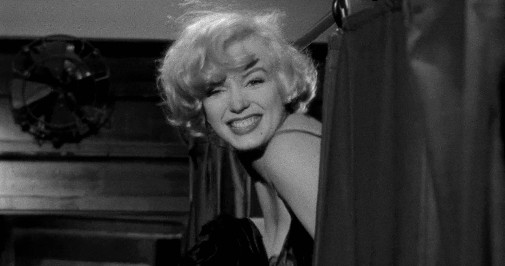
September started with the Venice Film Festival where Andrew Dominik's controversial Blonde premiered and closes with its arrival on Netflix. As a Marilyn Monroe fan who tried and failed to get through Joyce Carol Oates' doorstop of a novel, I had early apprehensions about this production and its fictionalized account of the star's troubled life. However, the combination of a gorgeous-looking trailer and moralistic backlash online led me to anticipate the movie with bullish optimism. Yet, having seen the thing, I'm afraid I can't sincerely take on a contrarian positive take nor defend most aspects of the misbegotten mess.
Worst of all, I'm stricken by the picture's puddle-deep purview of stardom, image-making, and Monroe herself as a person and phenomenon. Considerations of her as an actress are similarly shallow, verging on nonexistent. This is especially disheartening because, above all else, she was an amazing actress whose talent is often overlooked, either obfuscated by the glare of tragedy or dismissed by those who can't see beyond media objectification. So, to combat both narratives, let's remember Marilyn Monroe, the actress, in one of her best films – Billy Wilder's Some Like It Hot…
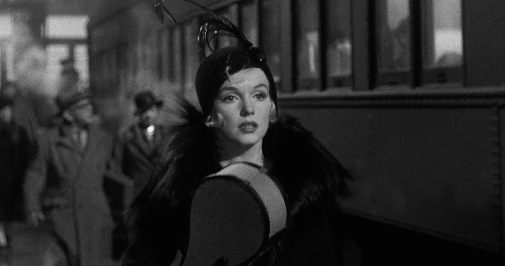
First, one has to address the elephant(s) in the room. There's no way around it – shooting Some Like It Hot was s a living hell for almost everyone involved, most of all Marilyn Monroe. She came into the project after an 18-month hiatus from Hollywood, time spent recovering from one of the multiple miscarriages she suffered while married to Arthur Miller. Judged as unprofessional by her colleagues, the actress was her unpredictable self. Sometimes, she worked through long scenes without a hitch, getting it done in one take. Then, other times, she floundered to remember a few short lines.
By all accounts, her mental state wasn't all that stable, made worse by a high-risk pregnancy that Orry-Kelly's Oscar-winning costumes work overtime to conceal. Before the production was over, she'd miscarry again, in part due to longtime issues with endometriosis. Monroe suffered but managed to produce movie magic along the way, elevating the role into a full-bodied, three-dimensional character that works as the glue holding the film together. She's its aching wounded center, wherein mirth and misery swirl into each other, embracing until two become one. She's so good that some theorize Monroe's flubbing was intentional.
Maybe it was a way to get fired from a job she didn't want anymore. Or perhaps it was to wield power away from Wilder, ensuring her conception of Sugar ended up on-screen and that Paula Strasberg was allowed on set. Whatever the case, I'd argue none of it is of great importance when considering the merits of Monroe's performance. What's crucial is that it works, and boy does it work. So much so that I don't think you could tell that there was so much behind-the-scenes kerfuffle watching the film without further context. I know I didn't realize it when first encountering it as a classic comedy rather than a canonical title loaded with backstage gossip made myth.
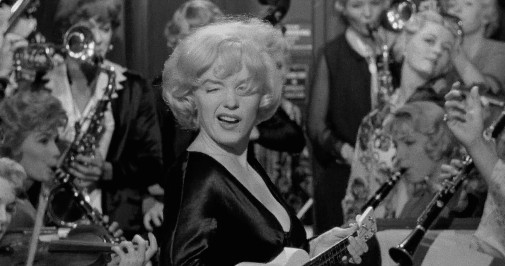
In that spirit, let's move on to the picture proper before finding more film shoot controversy to unearth. Adapted from the 1935 French film Fanfare of Love and its 1951 German remake Fanfares of Love (Teutonic audiences yearned for more than one fanfare), Some Like It Hot tells the story of two musicians on the run. In February 1929, Joe and Jerry find themselves in the wrong place, wrong time, becoming unwitting witnesses to a mass murder not unlike the real-life Valentine's Day Massacre. To escape the gangsters, the two disguise themselves as women and go on a trip to Miami as the new members of an all-female band.
While on the train, the newly baptized Josephine and Daphne find themselves in a tricky situation. To be safe, they must maintain their drag personas and lay low. However, the singer/ukulele player Sugar Kane is a gorgeous temptation who might just blow their cover. Keeping their desires under wraps, they become the woman's gal pals, but when in Miami, Joe devises a cunning plan to seduce her without revealing that Josephine isn't real. He assumes the identity of an impotent millionaire, as one does, and the two end up enamored through layers of duplicity. There's another romance brewing and more mafia drama to contend with, but that's the gist of it.
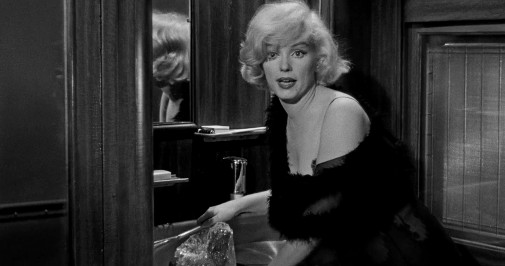
Initially, the part of Sugar was conceived as a supporting presence to Lemmon and Curtis' crossdressing shtick, intended as a sort of straight man figure amid the madness. Mitzi Gaynor was the intended star at this time, but her commitment to South Pacific's big-screen adaptation brought about unbendable scheduling conflicts. Though, according to some Wilder notes – he contradicted himself on the matter throughout the years– as the weakest part, Sugar needed the strongest casting, and only Marilyn Monroe would do. Not that the actress was so sure about her rightness for the role or even the script.
Legend says Monroe was mainly preoccupied with her character's motivations, but a piece of advice courtesy of Lee Strasberg solved the puzzle. Rather than playing up Sugar's potential stupidity regarding the disguised men, she instead conveys a desire for female friendship, something half-mad but heartfelt that transcends any mean-spirited judgments about the singer's wits. This is somewhat contradicted by the easy camaraderie between all the band members during their train journey. However, that doesn't matter when the backbone of Sugar's characterization makes such emotional sense. At times, it's like the film reimagines itself around her inner depths.

But of course, there's always darkness lurking beneath the froth, the earnestness. She's got a rocky past revealed in a negligee-clad monologue that hints at unsurmountable loneliness that's a bit like when you get the fuzzy end of the lollipop or are left with nothing but a tube of toothpaste with all the toothpaste squeezed out. Delivering these lines, tossing them off with casual self-loathing, Monroe illuminates her character's interiority and manages to reconfigure the way the in-film and off-screen audience regard her. There's longing, a need out of show business-bound existence lived between gigs and heartbreaks, a flask at the ready to soothe the pain.
All that said, Marilyn Monroe's performance in Some Like It Hot is not primarily an expression of sorrow. More than anything, it's a celebration of joy, funny and full of warmth, a sense of ebullience that carries you from the movie's frantic plotting to its quiet interludes. Such marvels relate closely to the star's unique presence, usually attributed to a singular mixture of vulnerability and provocation. However, to reduce Monroe to that is erroneous. Moreover, it doesn't begin to explain her comedic triumphs, chief among them Some Like It Hot. Consider that, despite on-set clashes, Billy Wilder had good things to say about his leading lady, stating that "She is a master of delivery. She can read comedy better than anyone else in the world."

Sugar also exemplifies a strange quality that Monroe always imbued her 'dumb blonde' characters with – intelligence. Like Lorelei Lee, Elsie, Miss Casswell, and many others before her, Sugar Kane née Kowalczyk wears naivete as a mask that's not even skin-deep. See beyond it, and you find pragmatism, broken dreams, an ability to see the world for what it is, and maybe a deliberate choice to look the other way. There's complex humanity in her portrayals of these women, even if directors and scriptwriters hadn't intended it to be so, a slight twist that cannily subverts sexist tropes even as it appears to support them.
Hell, the singer calls herself dumb in a moment of performed self-awareness that can't help but puncture the archetype. The subversion is done in a careful balance, never tipping too far into a betrayal of the film's ode to those who like it hot and surrender wholly to the pleasure of it all. The "I Wanna Be Loved By You" performance, for example, represents a pinnacle of Sugar and Marilyn's sexual objectification within Some Like It Hot, its hedonistic abandon in full bloom. Visually, figure-hugging tulle delineates the star's body, covered in sequins, lace, and fringe that look like whispers of glimmer over naked flesh when seen through the camera.

As far as Charles Lang's cinematography is concerned, this game of insinuation is underlined by the lighting, a shadow sitting midway through the cleavage like an immaterial coverup. It's a parody of modesty that only makes the sensuality more acute. Still, despite it all, this scene belongs to Sugar through-and-through rather than a metaphorical male gazer, and not just because she's the ogled body. Monroe's breathy delivery both serves as Betty Boop-like titillation and as an underlining of Sugar's softness, the tender soul existing out of reach and beyond the smokescreen of sex appeal. Indeed, she is sex personified, openly flirting with the camera and thus regaining power from it.
You see, this singer is never being unwittingly turned into sex on stage. She's performing it with full knowledge, looking around to see if it's working and if her target is watching. Part of it is the layers of performance implied when an entertainer plays an entertainer. Part of it is this magnetic charge that electrifies the screen whenever Monroe does away with one-dimensional sincerity and playacts putting on a show. Part of it is that the breathy delivery and coquettish mannerisms only appear when Sugar knows she's before men and recedes whenever it's just girls. From variation comes modulation comes dimension. Another scene that showcases this comes during the absurd seduction.

Using what he knows about her preferences in men, Joe creates Junior, the aforementioned millionaire character who's everything Sugar ever dreamed of. That goes beyond his superficial charms, wealth, and Cary Grant-like cadence. Embodying an idea of sweet helplessness, he becomes a passive figure in the seduction, allowing Sugar to be more dominant, active in her pursuit, convinced he's impotent and in need of her help. This game of traditional gender roles twisted out of shape depends on Monroe. Thanks to her, Sugar's beguilement is precisely articulated and laced with agency, a physicality revealing clear intent, while never betraying the script's comedic gambit or the singer's previous characterization.
For what it's worth, Curtis didn't like shooting this love scene, primarily because of his costar's demand for retakes. His fury was such that the actor later commented that kissing Monroe was like kissing Hitler. In her last interview for LIFE Magazine, the actress addressed her costar's words: "If I have to do intimate love scenes with somebody who really has these kinds of feelings toward me, then my fantasy can come into play. In other words, out with him, in with my fantasy. He was never there." She pulls it off, and all you can see on-screen is a fantasy made flesh, falling in love and lust crystalized in celluloid as prelude to pitiful heartbreak.

These candid sentiments, this flare of sensuality and want, are central to the movie and Marilyn's careful characterization. What you want is essential to what you are, after all. In more ways than one, Some Like It Hot is about who we are, as understood through what we want and pursue. It's about how one escapes from oneself and, in the process, finds another self that might be truer than the first. Or maybe it's just a better version of the past self, spruced up and energized by a new costume, a new outlook, and the revelations that come along with it. This happens to Joe and Jerry, clearly, but it's also Sugar's journey from that smoky train platform to the back of a motorboat going who knows where with only love on her mind.
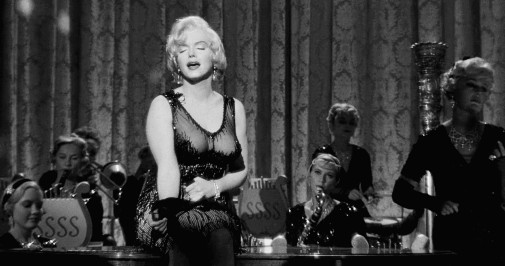
Though she made the industry fortunes beyond one's wildest dreams, Hollywood never had much respect for Marilyn Monroe. So it's no wonder an Academy Award nomination eluded her to the very end. Still, she came close for her comedic tour-de-force in Some Like It Hot, which earned critical acclaim and won her the Golden Globe along with other honors. Even international film festivals recognized her work, with the Faro Island Film Festival bestowing Monroe with a juried Best Actress prize as well as a trophy voted by its audiences. And yet, that wasn't enough for AMPAS. Though Some Like It Hot nabbed six nominations, Best Actress wasn't among them.
The five nominees in that category were Doris Day in Pillow Talk, Audrey Hepburn in The Nun's Story, Katharine Hepburn in Suddenly, Last Summer, Simone Signoret in Room at the Top, and Elizabeth Taylor in Suddenly, Last Summer. In an unexpected turn of events, the French star came out victorious. As for Monroe, she only completed two more features after Some Like It Hot – 1960's Let's Make Love and 1962's The Misfits. Though the latter presented another excellent opportunity to honor the actress, the Academy remained impassive regarding her brilliance, screen presence, and genius performances whose power endures far beyond a much-exploited, far-too-brief life.

Like many Monroe movies, Some Like It Hot is not available to stream but readily available to rent or purchase.